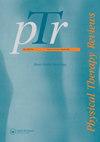验证一种新的患者报告的社区老年人平衡恢复信心(BRC)结果测量:一项研究方案
IF 0.8
Q4 REHABILITATION
引用次数: 1
摘要
背景:患者报告的结果测量(PROMs)为临床医生提供了对患者身体表现感知能力的更好理解。现有的关于跌倒功效的prom提供了有关老年人在不跌倒的情况下进行日常生活活动的感知能力的有意义的信息。然而,从滑倒、绊倒或意志运动中恢复平衡的感知能力尚未得到充分评估。平衡恢复信心与自我反应能力的判断有关。平衡恢复自信量表(BRC)是一种衡量感知平衡恢复自我效能感的新PROM。研究方案的目的是描述BRC测量特性的第一次心理测量评估。目的本研究是在新加坡进行的新开发的PROM的验证阶段。方法对200名65岁及以上的社区老年人进行5项自述量表(BRC、活动特定平衡信心量表、跌倒疗效量表-国际、晚年功能和残疾量表-功能和整体感知效应)和3项性能测试(手力量测定仪、30秒站立椅、Mini BESTest)。经典的测试理论方法将评估可接受性、数据完整性、项目的针对性、尺度假设、内部一致性、信度和结构效度。因子分析将建立单一性。Rasch分析将评估项目契合度、差异项目功能、反应量表排序、人与项目的目标和可靠性。结果本研究的结果将发表在同行评议的期刊上,并在康复相关的国家和国际会议上发表。结论:这是BRC的首次验证性研究。该研究将为临床医生和研究人员在秋季管理研究和临床实践中使用BRC提供信心。本文章由计算机程序翻译,如有差异,请以英文原文为准。
Validation of a new patient-reported outcome measure of balance recovery confidence (BRC) for community-dwelling older adults: a study protocol
Abstract Background Patient-reported outcome measures (PROMs) provide clinicians a greater understanding of patients’ perceived ability in their physical performance. Existing PROMs on falls efficacy provide meaningful information about the perceived ability in older people to perform common activities of daily living without falling. However, the perceived ability to recover balance from a slip, a trip, or volitional movements has been inadequately assessed. Balance recovery confidence relates to the judgment of self-reactive ability. The scale of balance recovery confidence (BRC) is a new PROM that measures perceived balance recovery self-efficacy. The purpose of the study protocol is to describe the first psychometric evaluation of BRC’s measurement properties. Objective This study is a validation phase of a newly developed PROM conducted in Singapore. Methods Two hundred community-dwelling older adults, aged 65 years and older, will complete five self-reported instruments (BRC, Activities-specific Balance Confidence Scale, Falls Efficacy Scale-International, Late-Life Function and Disability Instrument-Function and Global Perceived Effect) and three performance measures (Hand strength dynamometer, 30-second Chair Stand, Mini BESTest). Classical test theory methods will assess acceptability, data completeness, targeting of the items, scaling assumptions, internal consistency reliability and construct validity. Factor analysis will establish unidimensionality. Rasch analysis will evaluate item fit, differential item functioning, response scale ordering, targeting of persons and items and the reliability. Results The findings from this study will be published in peer-reviewed journals and presented at national and international conferences in rehabilitation-specific context. Conclusions This is the first validation study of BRC. The study will give confidence among clinicians and researchers to use the BRC in fall management research and clinical practice.
求助全文
通过发布文献求助,成功后即可免费获取论文全文。
去求助
来源期刊

Physical Therapy Reviews
REHABILITATION-
CiteScore
1.30
自引率
0.00%
发文量
26
期刊介绍:
Physical Therapy Reviews is an international journal which aims to publish contemporary reviews, discussion papers and editorials within physical therapy, and in those basic and clinical sciences which are the basis of physical therapy. The journal is aimed at all those involved in research, teaching and practice within the area of physical therapy. Reviews (both descriptive and systematic) are invited in the following areas, which reflect the breadth and diversity of practice within physical therapy: •neurological rehabilitation •movement and exercise •orthopaedics and rheumatology •manual therapy and massage •sports medicine •measurement •chest physiotherapy •electrotherapeutics •obstetrics and gynaecology •complementary therapies •professional issues •musculoskeletal rehabilitation
 求助内容:
求助内容: 应助结果提醒方式:
应助结果提醒方式:


